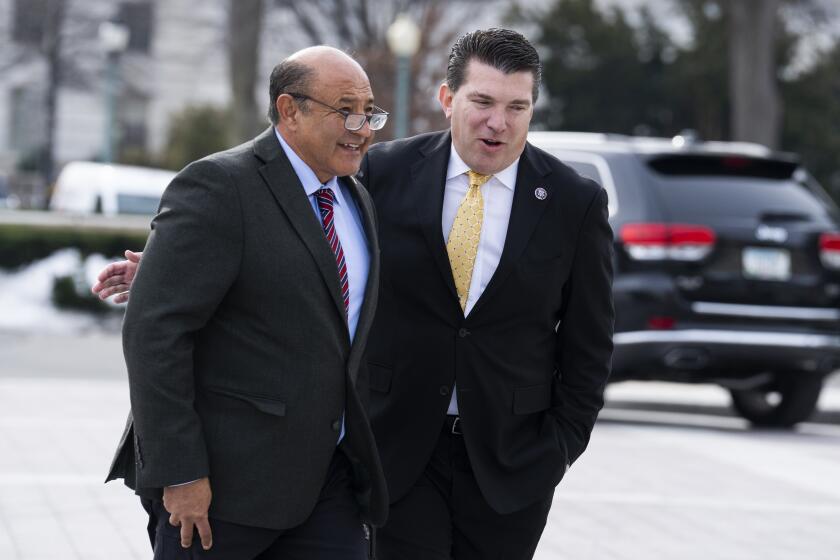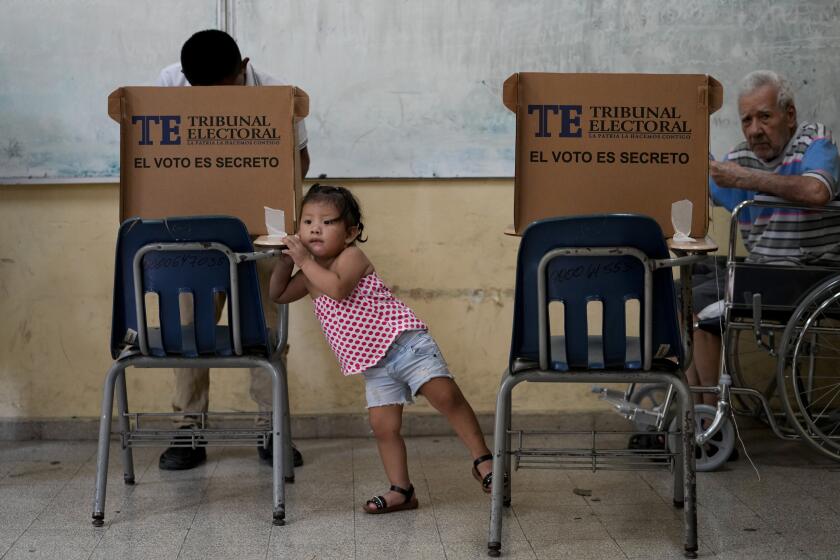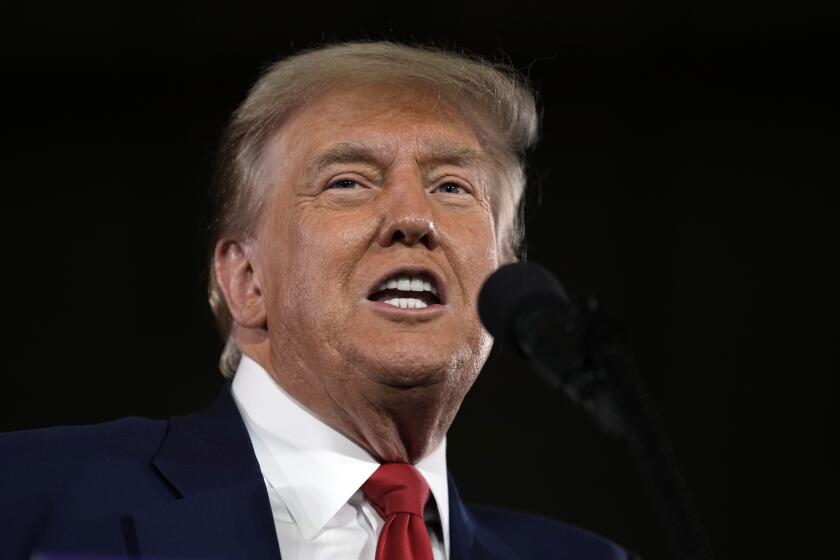Paper Tainted by Ties to Right Wing, Moon Church : Washington Times Fights for Its Niche
The Washington Times has lost more than $200 million--perhaps more than $250 million--since it began publication five years ago as “an alternative, conservative voice” to the Washington Post. But it’s also become a serious and controversial player in the political/media arena of the nation’s capital.
Patrick J. Buchanan says that when he was White House communications director, “It was read by everybody before the senior staff meeting . . . . It’s got things . . . you can’t find elsewhere . . . a lot of stories . . . the President would make phone calls on the basis of.”
One reason people in the Reagan White House read the Washington Times is that the paper is avowedly conservative and anti-communist--so vigorously so that some staffers and readers say it distorts the news.
Washington Times editors deny this charge, but four months of reading the paper (and interviewing the people who run it and work for it) leaves one with the clear impression that its proprietors--a company owned by members and officials of the Rev. Sun Myung Moon’s Unification Church--are far more interested in promoting anti-communism than Moonie theology with their newspaper.
The Washington Times is not just a handmaiden to the American right wing, though. Indeed, it was the Washington Times that first broke (and most aggressively pursued) the story of the lobbying efforts of former White House aide and Reagan intimate Michael K. Deaver (who has since been indicted for perjury).
The Washington Times breaks a lot of stories these days--in Washington and out--despite an editorial staff of just 230 men and women. (The Post has 540.)
Just last Wednesday, the paper broke a story that a confidential log containing the names of 500 people who had been tested for AIDS had disappeared from a city health clinic. The paper has also broken stories on the planned resignation of James G. Watt as secretary of the Interior; on the defection of Soviet KGB official Vitaly Yurchenko; on Sen. Paul Laxalt’s secret 1985 mission to the Philippines with a special warning from President Reagan for then-President Ferdinand E. Marcos, and on French Premier Jacques Chirac’s charge last year that West German Chancellor Helmut Kohl believed that a purported plot to blow up an Israeli jetliner was concocted by Israeli intelligence.
The Washington Times has won awards for its sports section and for its design, as well--it’s one of the half-dozen or so most attractive, best-packaged papers in the country--and the director of the National Gallery of Art says the paper’s art critic, Jane Adams Allen, is “one of the best in the business.”
Joseph Laitin, who writes a column on the press for the Post and who has long been critical of his own paper’s selection of stories for Page 1, says: “The Washington Times, on the whole, has better judgment of what to put on Page 1 than the Post does.”
In fairness, it should be pointed out that the Washington Times has also missed some good stories (most recently, the purchase of Vincent van Gogh’s “The Sunflowers” for nearly $40 million) and that its zeal for scoops (and its faith in the Reagan Administration) has also led it astray at times--as when it reported last year that American intelligence officials said (mistakenly, it turned out) that Libyan leader Moammar Kadafi had fled the country after the U.S. bombing raid there.
Far From Truly Competitive
For all its progress, the Washington Times is still far from being truly competitive with the Post, and even its most optimistic executives don’t project a circulation beyond 250,000--which would be more than double its present 104,186 . . . and would still be about one-third the size of the Post’s 735,998.
The Post reaches 52% of the homes in its metropolitan area during the week and 70% on Sundays--by far the greatest penetration/domination enjoyed by any major metropolitan paper in the country.
More important, since advertising revenue covers about 75% of the cost of publishing most daily newspapers, the Post now makes $112 for every $1 the Times makes in advertising revenue.
If it weren’t for the Unification Church, “anybody who’s a smart advertiser in Washington . . . would be supporting that paper . . . “ says James K. Glassman, former publisher of the New Republic and now publisher of Roll Call, a weekly newspaper on Capitol Hill.
But advertisers seem reluctant to risk being tainted by association with the church. Moreover, the history of second newspapers in major American cities over the last 20 years suggests that even without the taint of church affiliation, the Washington Times would have trouble attracting large quantities of advertising.
Nevertheless, circulation of the paper did increase 17.6% last year, and advertising increased 51% in revenue and 30.5% in linage from fiscal 1985 to fiscal 1986 (which ended March 31).
Profit Not Immediate Goal
The Washington Times’ $4.2-million ad revenue in fiscal 1986 (contrasted with the Post’s $473 million) seems laughably small, but as long as the church leaders and members who founded the paper maintain their financial commitment to it, profit is not an immediate goal.
Paul Rothenburg, general manager of the paper, says he would like the paper to break even by 1994, but that seems unlikely. Ron Godwin, chief financial officer and senior vice president of the Washington Times Corp., says candidly, “I don’t have to make money . . . this year or the next year or the next year.”
Godwin, who was previously administrative assistant to the Rev. Jerry Falwell and executive vice president of Falwell’s Moral Majority, says the paper must ultimately make money to be taken seriously, and he was brought to the Washington Times last fall to bring that about.
Meanwhile, the paper has just completed a $500,000-market research project, and on May 17--its fifth anniversary--the Times will begin phasing in a revamped daily paper based on that study. The new paper--which, judging from prototypes, will be even more attractive than the current paper--will have a weekend magazine every Thursday, an expanded and separate daily business section, separate daily sections for sports and metropolitan news, a full-page, daily news summary, a weekly television magazine and many other features, several of which have long been standard in the Post and in most other major metropolitan dailies.
News World Communications, which publishes the Washington Times, also publishes a weekly newsmagazine (Insight); a monthly academic journal (The World & I); the New York City Tribune (a more directly church-related paper); a daily Korean paper and a weekly paper for blacks, both in New York; and a Spanish-language paper (Noticias del Mundo) based in New York with a national edition sold in Los Angeles, Chicago and San Francisco.
Church leaders also publish newspapers in Cyprus, Japan and Uruguay. But it is the Washington Times that is the centerpiece of the Moonie media empire--all the more so since questions about the church’s role in the paper have gradually diminished as the paper has gained in both quality and acceptance--and as evidence of overt church influence has failed to materialize in its news and editorial columns.
This is especially true in the two years since Arnaud de Borchgrave, former chief foreign correspondent for Newsweek, became editor-in-chief of the paper and both energized the staff and gave the paper his uniquely personal, politically provocative stamp.
De Borchgrave is an aggressive--many say an obsessive--anti-communist, and stories on the threat of communism--in Nicaragua, in Afghanistan, in the United States, even in Switzerland--so dominate the paper that at least two Washington Times reporters have posted “Commie-basher” signs on their desks.
With the fight against communism the top priority of Unification Church leaders, De Borchgrave is the ideal editor for the paper.
One day early this month, the Washington Times published two stories about the Soviets on Page 1--and 15 others inside the paper dealing with communism, the Soviet Union, other Eastern Bloc countries or Nicaragua. On another day, four of seven reviews of adult books in the paper’s weekly book review dealt with subjects related to communism.
De Borchgrave’s anti-communism--and, especially, his interest in Soviet disinformation (about which he co-authored the best-selling novel “Spike”)--manifested itself almost as soon as he came to the Washington Times in March, 1985. The paper published a five-part series, “KGB: Target America,” in May, 1985. (But when the Post disclosed last fall that the Reagan Administration had deliberately leaked false information to the press on Libya’s Kadafi, the Washington Times headline dismissed the report as “a bedtime story.”)
De Borchgrave is especially concerned about the communist threat in Nicaragua, and he insists on having the paper refer to the contras as “the Nicaraguan resistance;” he says “contras” is a term of the “ideological left.”
Glenn Garvin, the Washington Times’ Latin American correspondent, says that when he wrote a series of articles on conditions in Nicaragua last year, De Borchgrave killed the one article in the series that raised serious questions about the contras’ prospects for overthrowing the Sandinista government.
De Borchgrave insists he didn’t kill that story for political reasons, only because the series was “devouring too much space.” But the Washington Times routinely publishes more Page 1 stories on the contras than any other major paper in the country, and Foreign Editor Holger Jensen says De Borchgrave told him he’d killed the story because it “showed a certain naivete.”
(This wasn’t the first time one of Garvin’s stories was killed under questionable circumstances. Editors also refused to run a story he wrote two years ago about problems the press has covering South Africa--including his own two-hour detention by authorities.
(The Washington Times is generally sympathetic toward the South African government, but editors denied there was any political motivation in that decision either.
(Managing editor Wesley Pruden says he killed the story because “I don’t think that stories about difficulties reporters have getting stories very often make a good story. We all have trouble with . . . cops that rough us up. That’s just the nature of the job.”
(But last year, when Garvin was detained for nine hours by Sandinista authorities in Nicaragua, the paper ran his lengthy account of the experience on Page 1 of the paper, under the headline, “Times Reporter Gets Taste of Paranoia, Sandinista Style.”)
Two weeks after the House of Representatives rejected President Reagan’s request for aid to the contras last year, De Borchgrave announced in a Page 1 editorial that the paper was sponsoring a worldwide fund-raising campaign to collect $14 million for the contras.
Many Washington Times staff members objected to the fund-raising campaign as compromising the paper’s journalistic integrity; they signed a petition of protest. De Borchgrave--who proudly describes himself as the “point man” for the contras at the Times--refused to accept it, and the reporters say they were told by another editor, Woody West, that if they persisted with the petition they should “deem (themselves) to have resigned.”
It didn’t help matters that De Borchgrave’s editorial said the Unification Church had pledged $100,000 to the fund drive. That not only offended Times staffers but also fueled the continuing curiosity and skepticism about Moon, his associates in the Unification Church and their role in the Washington Times.
Church officials and editors at the paper think they should be accorded the same respect as, say, the Christian Science Monitor or the Mormon Church’s Deseret News in Salt Lake City. One reason they don’t enjoy this respect may be a xenophobia directed toward Moon and the other South Koreans who run the Unification Church.
The church has also been dogged by a series of strange incidents--among them a 1984 knife attack by unknown assailants on a Japanese journalist who had been fired as editor of the church-controlled paper, and who was then working on a magazine article critical of Moon.
Some of the church’s controversial theories and practices--secrecy, mass weddings and allegations of brainwashing, anti-Semitism and ties to the South Korean CIA--also arouse much curiosity and hostility. Indeed, the church continues to be the subject of widespread speculation in Washington political and journalistic circles, even if that specultion is not as pervasive as it once was.
The first three questions people tend to ask about its involvement with the Washington Times are:
--Do church leaders really permit the paper to operate independently?
--Where does all the money for the paper come from?
--Why are church leaders willing to spend so much on what most people think is a losing proposition?
The Washington Times lost about $35 million last year, and its parent company, News World Communications, expects to spend another $35 million on it in fiscal 1987-88. News World also expects to spend $30 million on Insight, an estimated $12 million on The World & I and $15 million on a new printing plant.
That’s a net expenditure of $92 million in one year; even if the company is correct in forecasting revenues of about $12 million--which would be double the 1986-87 income--News World would still lose $80 million on these ventures this fiscal year. That would bring its total losses on the Washington Times and its related publications to at least $300 million, perhaps considerably more, since 1982.
That’s a lot of money, and where there’s a lot of money, there’s almost invariably controversy and suspicions of impropriety. Indeed, in 1975, the Korean Cultural and Freedom Foundation--the brainchild of Col. Bo Hi Pak, Moon’s top aide and the president of News World Communications--lost its tax-exempt status and was forbidden to raise funds in the state of New York after a state audit showed that only 2.1% of the $1.2 million raised by the organization’s children’s relief fund was spent for designated purposes.
Key Figure in Scandal
Pak was a central figure in the Korean influence-buying scandal of the mid-1970s, and in 1978, a congressional subcommittee investigating that scandal said the “Moon organization” had “systematically violated U.S. tax, immigration, banking, currency and Foreign Agents Registration Act laws, as well as state and local laws relating to charity, fraud . . . . “
The committee urged that the Moon organization be “investigated thoroughly.”
Six years later, Moon himself was imprisoned for income tax evasion.
Pak was not charged with any crime.
Moon did not respond to a written request for an interview for this story, but in a rare interview--75 minutes on the telephone from Seoul on Friday--Pak attributed Moon’s imprisonment, the congressional investigation and other church clashes with the authorities to “disinformation” spread by church enemies determined to “discredit us and destroy us.”
In a sense, though, Moon’s conviction was the best thing that could have happened to legitimize his movement. He claimed that the $162,000 he was accused of not paying taxes on was money he was holding in trust for the church, and many previously hostile religious and civil liberties groups rallied to his side.
When Moon was released in August, 1985, after having served 11 months in prison and two months in a halfway house, 1,700 friends, followers and religious leaders turned out to honor him as a religious martyr in a “God and Freedom” banquet in Washington.
Jailing Called ‘a Disgrace’
Pak says Moon’s imprisonment was “a disgrace,” and he denied any impropriety by the church or by any of the organizations or businesses affiliated with it--a sprawling empire of so many commercial enterprises and religious, cultural, political, academic and journalistic organizations worldwide that even Pak says, “I do not have . . . a good idea what our entire worldwide movement involves.”
There’s Causa International and the Collegiate Assn. for the Research of Principles and the International Cultural Foundation (which has had 25 Nobel Prize winners attend its various forums) and the International Conference of the Unity of Sciences and the Professors World Peace Academy and the International Religious Foundation and the International Federation for Victory Over Communism and the World Media Assn. (which has taken 2,500 journalists from small- and medium-size newspapers and radio and television stations on fact-finding tours abroad) and . . . .
The church itself has an annual budget of $50 million to $100 million in this country--most of it raised in donations, according to Mose Durst, president of the United States branch of the church. So where does the money for the Washington Times come from?
It is widely thought that the church loses money or makes only marginal profits on most of, if not all, the businesses it owns in this country--among them, a merchandising company and various companies that build ships, sell flowers and produce films. (Pak says that analysis is “generally . . . correct.”)
Profit and loss vary considerably in other businesses owned bychurch members and officials--including fishing operations in Alaska and Massachusetts, a hotel, an opera center and a book publishing company in New York, catering and janitorial services in California and the money-losing News World publications.
The church and its affiliates have been much more successful with their business interests elsewhere--including South Korea, where the church’s enormous Tong Il Co. Ltd. manufacturing plant produces machine tools, automobile parts and--Pak says--a small amount of military hardware.
The church also owns an extremely lucrative ginseng processing and marketing operation, plants producing titanium dioxide and stone vases and various banking and real estate interests.
Pak says funds for the Washington Times don’t come from “any one source” but from various businesses owned by church members and officials throughout the world, especially in Japan and Korea. Profits from the worldwide business interests of Japanese church members are the largest single source of funding the paper, Pak says.
That’s not surprising. Durst says the church has more members in Japan than in any other country (including Korea).
(The church claims a membership of 2 million to 3 million in 130 countries, with 75% of the members in Japan and Korea and 55,000 in the United States, Durst says. Only about 100,000 members are what Durst calls “hard-core . . . proselytizers;” 15,000 of these are in the United States, he says. Others have suggested that these figures are exaggerated--that the church has only about 50,000 active members worldwide and 3,000 to 8,000, perhaps fewer, in the United States, where growth has slowed considerably in recent years.)
The Washington Post conducted a lengthy investigation into the question of Washington Times financing in 1984 and concluded that since 1975, at least $800 million had been funneled into the church’s political and business operations in the United States, including the Washington Times, from businesses operated by the Japanese branch of the Unification Church.
But others have speculated that some of the money for the Washington Times might come from foreign governments sympathetic to the church’s anti-communist position--governments in South Africa, Pakistan, South Korea, Taiwan, Central America and Uruguay (where the church has invested more than $70 million to buy a bank, a newspaper, a hotel and several other businesses).
The purported South African connection is a special favorite of critics who disagree with the Washington Times’ support of that country’s policy for dealing with apartheid. This theory draws added support because of the presence on the Washington Times Advisory Board of John P. McGoff, who was accused of failing to register as a foreign agent after trying to buy the Washington Star in the mid-1970s, allegedly with $11.35 million provided by South African government officials. (A federal judge dismissed the case against McGoff last December.)
Other speculation focuses on the South Korean government--or the South Korean CIA--as the source of the Times’ funding. Pak is a former military attache at the South Korean Embassy in Washington; Pak’s top deputy at News World, Sang Kook Han, was formerly the South Korean ambassador to Norway, Iceland and Panama.
Moreover, a declassified summary of U.S. intelligence agency reports, cited in the 1978 congressional investigation, said the Korean CIA “had used Moon and members of his Unification Church to stage rallies in the United States in support of Korean government policies and aims, and on at least one occasion Moon received KCIA funds for that purpose.”
Pak says the Washington Times doesn’t receive “one red cent” from any foreign government, and he says there is no connection between the Korean CIA or the Korean government and either the Unification Church movement or the Washington Times.
Despite considerable effort, no one has proved otherwise, and the Moon movement would certainly seem to have enough other sources of income to keep the paper afloat.
The French newspaper Le Monde estimated two years ago that annual profits from church and church-related business ventures amounted to about $700 million.
There have been reports of infighting within church councils from time to time about the wisdom of spending so much of this money on the Washington Times.
“There are other leaders in . . . the church who want to do things . . . somewhere else that won’t get done because (the Washington Times), Insight and other publications here require so much of a subsidy,” says Godwin of the Washington Times Co.
So why does the church and its affiliates continue to pour all this money into the Washington Times?
Susanna Shuster and Barclay Walsh of the Los Angeles Times editorial library assisted with the research for this story.
More to Read
Start your day right
Sign up for Essential California for news, features and recommendations from the L.A. Times and beyond in your inbox six days a week.
You may occasionally receive promotional content from the Los Angeles Times.






